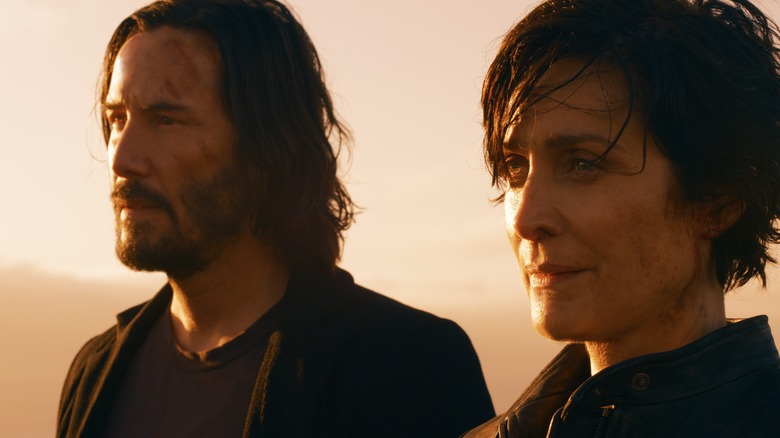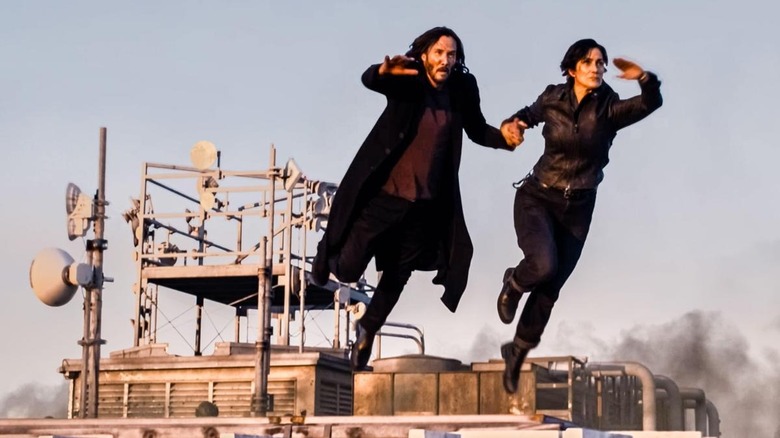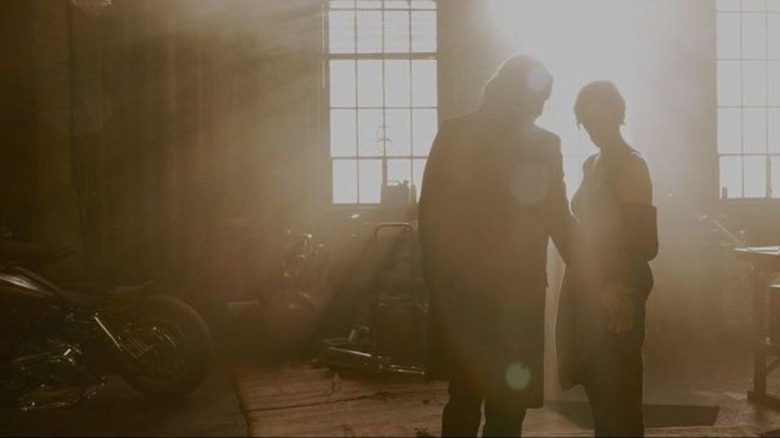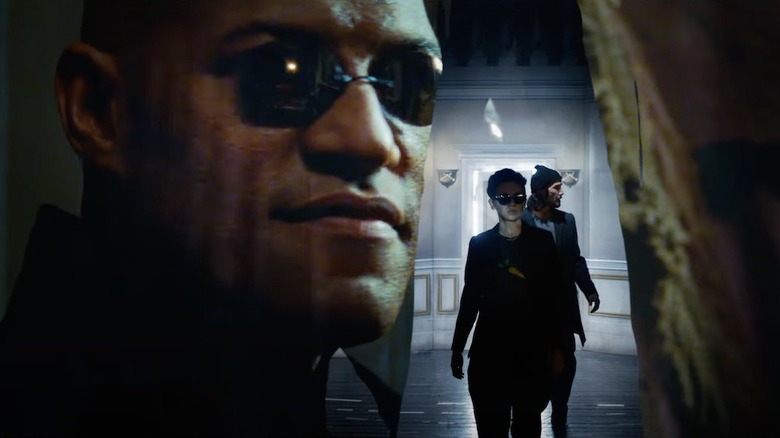The Matrix Resurrections Cinematographer Daniele Massaccesi On Embracing Natural Light [Interview]
Lana Wachowski is embracing quantum magic moments now. In the past, "The Matrix Resurrections" director wanted to control the image and the light as much as possible. Now, she often wants to wait and see what happens. "When I was very young, I was afraid of the sun," she once said. "I was afraid of natural light. I really loved control over light. I loved to model things and make things perfect. The thing about the sun is, it is just moving and changing. Every moment is different. That was too terrifying to make a film with."
With cinematographers John Toll and Daniele Massaccesi, Wachowski presents the sunniest "Matrix" film to date. It's eye-popping work full of natural light. The abundance of light is perfect for the story, of course, with Thomas Anderson opening his eyes again and the fight for brighter days ahead in the world. "The Matrix Resurrections" is, after all, the feel-good entry in the franchise. Recently, cinematographer Daniele Massaccesi told us about embracing natural light with Lana and his experience on the sequel.
"She had a completely different approach to filmmaking and to life."
Lana has been using more natural light over the years. She wanted to use more on "The Matrix Resurrections," right?
Well, I've been working with Lana for a while now, and we went from "Cloud Atlas" to "Jupiter Ascending." Actually, before that, I worked with them on "Speed Racer." Just a brief, brief time. So, yes, she changed the way she look at filmmaking quite a lot from the beginning to now. Obviously, she's more involved into real work instead of just CG stuff, and obviously, lighting is a big part of it. She'd rather use sunlight to light a scene than having artificial light. So, even though we cheat a few times, for a few scenes we actually recreate the sun, putting in basically a big light in the middle of frame. As much as we can, we'd rather find a location with the real sun and use that as the main source of lighting. She had a completely different approach to filmmaking and to life, where she'd rather have it in real. You've seen the movie so you know that they actually, at the end of the movie, the actors jumping off the building. The real actors are jumping off the building.
How was it shooting that moment?
At that time, obviously, was just camera operator. John Toll was still there because they were showing San Francisco. Lana was quite keen of the time when she wants to shoot the scene. Obviously, if she wants the sun just coming off the horizon, faded, beautiful, that you can see at dawn every day, it gives you a very small window to do a shot so important. So, for a few times we were on the rooftop of the building in the dark, getting everything ready to do it, and then, as the sun breaks the horizon, we just did it. And as an operator, that was actually a challenge shot because you have main actor jumping off a 100 floor building, and you have a camera leading them in front, so as they jump you need to follow them as they go down. Make sure they are in frame. It's not like you can miss it, so that was a bit of a challenge.
So, she's definitely involved into real lighting now, and she'd rather use the sunlight as the main source. Also, the scene in the motorcycle shop, when they actually kind of have fun of the bullet time, it was the same thing. We went on the set and we look at the sunlight coming through. The light was good between eight o'clock in the morning to 11:15, so we went there for a week and the filming for three hours, from eight o'clock to 11:15. And then we go back to the studio and are prepping other stuff. But, as she said, the beauty of the real sunlight is you can't repeat in any other way.
"It allowed us to go longer and shoot the rest of the scene."
I talked to the writers yesterday. They said Lana prefers to work from her gut and trust her instincts on the day. Is that your experience as well?
Yeah. Also, the way she decided to film, basically we shot everything on a Steadicam, and I was operating the Steadicam and she was right behind me and looking at my monitor. She can adjust for whatever is happening. So, she had a rough idea where the scene is going, but then, as you said, feels her gut, and once you see the actor performing, then your plan might be out of the window, so you need to find another plan. Working that way gives her the opportunity to quickly adjust to what the scene is becoming, and same thing for the lighting.
Because the lighting, as well, it's either the sun is hitting a different place, or doing something different, or the light is doing something different, and you need to adjust. Obviously, there's less control, but sometimes that stuff that is more natural gives you that reaction, that stuff from the actor, that you never get if you do 20 takes. So it's definitely a different approach.
Do the action scenes require more control? For example, the warehouse fight sequence.
The big warehouse was mostly the real sunlight. We are waiting for the best time of filming, and film most of this stuff, the big stuff, and then, whenever we need to do small pieces, we bring a big crane with some lights on. It allowed us to go longer and shoot the rest of the scene. So, it is a bit of a mix of artificial light, mostly real sunlight, but also some artificial light as well. Try to fill the gaps in between. It was a long fight scene.
What were some of the challenges of that, because it is so many moving pieces and characters?
I know. Follow every single piece of all the actors fighting different places, and finding what the best time to film every single piece. I must say the movie very challenging. Also, well, my first big movie as a director of photography, and obviously that was a big challenge. And, to be honest, she was such a big support. The fact that she was on set with me, and she would immediately understand if I have a problem and help me to fix it. Another big part of a new approach to filming is, she's enjoying being on set. Everything has a solution, so we need to just find which one it is. No struggle, no reason to be miserable. We find a way to make it through, and enjoying what we are doing because we are so lucky. There is no reason to be miserable, to be honest.
"We don't need to be green."
Since this is over 20 years after the first film and how times have changed, how'd you want to present the Matrix differently?
Funny, I was reading a comment about when the trailer got released, of people saying, "Oh, why they didn't use the green filter?" Green because obviously everybody remembers the Matrix to be green. Think of the way computers developed so quickly in 20 years. In the beginning, computer was a black screen with a blinking, all the writing was green, everything was green. Wasn't much color in it. So, at that time, it would make sense to have that kind of green look to the Matrix.
First of all, that would tell you immediately where you are. Also, the fact that made sense, the computer were green so the green makes sense. But now computers are different, they're not green anymore. And, actually, the reality that can create sometimes even looks even more real than the reality itself, so we decide to go, "Let's make it beautiful. Let's make it look beautiful. We don't need to be green. We don't need to be the same idea that was original." Because it's 20 years later, the characters are 20 years later, everything is 20 years later, and things have developed. So it allowed us to have more freedom, and have more fun in a way, to create a new look.
Anything about the camera work and aesthetic of those previous films, though, that you did want to keep?
Well, again, obviously at that time everything was planned and every single shot was planned, and everything has to be perfectly as originally planned. Now she's filming a complete different way, so nothing is really planned, we go with the flow. So the way, also, the camera moves and everything is, wasn't as it was in the original movie because there was no plan. We decided what to do on the flow. We were standing there and the actor would do something, and we would say, "Well, let's go, right? I think it's going to look great if we go that way." Or, "Let's go the other way, it looks better." So it was not really as planned as it was, which is a different way. I don't think that she wanted to do the same kind of movie. She wanted to show that things have changed after 20 years, and we all change. The actor had changed and she has changed, so I think she decided to kind of step away from the original movie and create something different.
With Keanu Reeves, how did a performance of his on the day influence where you put the camera?
Well, the scene in the theater, when he walks in the theater and then realized that he's seeing himself younger. And that day was very emotional for everyone. Lana, going back to... You get the new movie with the old movie, and Keanu sees himself on the screen, 20 years younger. We want to create that surprise and wasn't really a plan. As Keanu walked into the theater and then turns himself and he sees himself, and you can see on his face, he was like, "Oh." I had a little talk with him and he said, "Yeah, that day was quite heavy for both of us. For me and Lana, because you're going back to something that is gone." Basically, you are a different person now and you'll never go back to what you see on the screen, and you had to deal with it.
Keanu and I had a little talk on the fact that sometimes everything goes so fast. You get up in the morning, you go to work, and then suddenly you face a scene like that, where you actually need to find it. Sometimes not having a plan, maybe it's better because what comes out is the real you and the real emotion that you have inside. When you start thinking too much about things, then maybe it's too constructed and not I would say, natural, what comes out. Because you have so much time to think about it. It was actually a big challenge for Keanu, but I think it's probably one of the best movies I've seen from Keanu in a while, to be honest. Not offending anything else. But, as an actor, I think he did a great job.
"The Matrix Resurrections" is now in theaters and on HBO Max.



